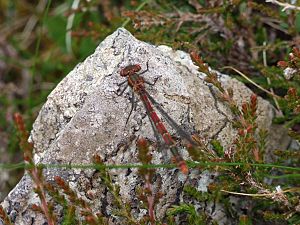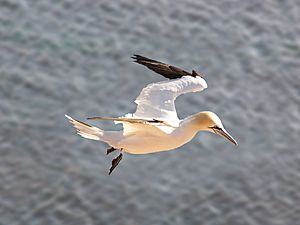Flora and fauna of the Outer Hebrides facts for kids
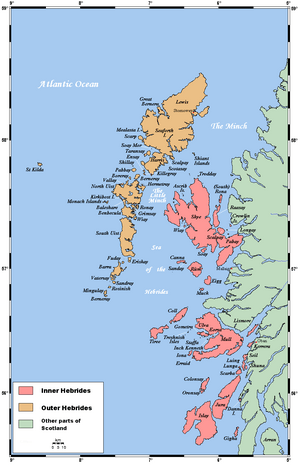
The Outer Hebrides in northwest Scotland are home to amazing plants and animals. This long chain of islands sits on the edge of the Atlantic Ocean. It attracts many different seabirds. Thanks to the Gulf Stream, the weather is milder than you might expect for how far north it is. This warm ocean current also brings unusual visitors sometimes!
Contents
Amazing Animals of the Outer Hebrides
Birds: Feathered Friends of the Islands
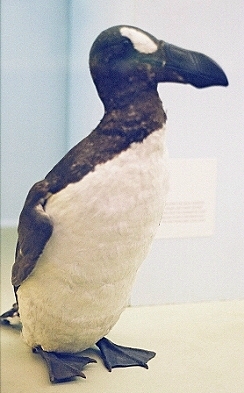
Over 320 types of birds have been seen in the Western Isles, and more than 100 kinds breed here. The islands are like a natural highway for birds migrating to and from their Arctic homes. They also offer a safe place for birds blown off course from America and northern Europe. Many birds nest here, including most of Britain's corncrakes, which live on the islands' farmlands.
You'll find many seabirds along the coasts, like shags, gannets, fulmars, kittiwakes, guillemots, and the common seagulls.
In the Uig hills on Lewis, you might spot golden eagles. Some people even say they've seen white-tailed eagles there! In the Pairc area, look for oyster catchers and curlews feeding.
A few pairs of peregrine falcons live on coastal cliffs. Merlins and buzzards are also common in the hills and moors. Red-throated divers nest on small lakes, and a few black-throated divers can be found on bigger lochs. Arctic skuas are spreading south, but great skuas still mostly breed in Lewis, St Kilda, and other specific islands.
In winter, many different kinds of wildfowl arrive. Various ducks, like eider and long-tailed ducks, live in the shallow waters around Lewis.
Great Bernera is home to many seabirds, including gulls, waders, and ducks like goldeneye. In 2007, a rare jack snipe was seen there!
The Shiant Islands have huge numbers of seabirds. Tens of thousands of Atlantic puffins nest in burrows on Garbh Eilean. There are also many common guillemots, razorbills, northern fulmars, black-legged kittiwakes, common shags, gulls, and great skuas. While St Kilda has more puffins, the Shiants have a higher density of them.
Berneray: A Birdwatcher's Paradise
The farming methods on Berneray help many birds thrive. On summer evenings, you might hear snipe drumming or even the call of a corncrake. Mute swans can be seen on Loch Brusda, and greylag geese are common. In winter, barnacle and a few brent geese join them. Ravens and buzzards are often seen. Golden eagles and hen harriers are rarer, usually appearing in winter.
Wading birds on the shore include redshanks, sanderlings, turnstones, oyster catchers, dunlin, curlews, whimbrels, ringed plovers, and herons. Further out, around Berneray's shores, you'll find mallards, eiders, red-breasted mergansers, and sometimes black-throated and great northern divers. Shags and cormorants fish here all year, and in summer, you can watch gannets diving.
St Kilda: Home to Millions of Seabirds
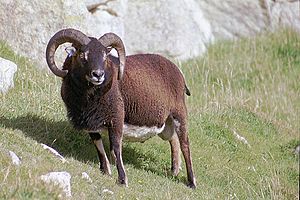
St Kilda is a vital breeding ground for many seabirds. It has the world's largest colony of northern gannets, with 30,000 pairs, making up 24% of the global population! There are 49,000 breeding pairs of Leach's petrels, which is up to 90% of the European population. Also, 136,000 pairs of Atlantic puffins (about 30% of the UK total) and 67,000 northern fulmar pairs (about 13% of the UK total) live here. Dùn has the largest fulmar colony in the UK. Before 1828, St Kilda was their only UK breeding spot, but they have since spread.
The last great auk seen in Britain was killed on Stac an Armin in July 1840. In 2007, scientists saw unusual behavior from St Kilda's bonxies. Using night vision, they watched skuas hunting petrels at night, which is very rare for a seabird! A special kind of Eurasian wren, called the St Kilda wren, lives only on St Kilda.
Marine Life: Under the Waves
Salmon swim up several Lewis rivers after crossing the Atlantic Ocean. Many freshwater lochs (lakes) are home to fish like trout. Other freshwater fish include Arctic char, European eels, sticklebacks, thick-lipped mullet, and flounder.
Offshore, you often see seals, especially in Stornoway harbour. If you're lucky, you might spot dolphins, porpoises, sharks, and even whales. Sometimes, turtles, mainly loggerhead and leathery types, are seen in coastal waters.
In Great Bernera, sea life is very rich where the tide flows between the Caolas Bhalasaigh (Valasay Straits) and the inner sea-loch of Tòb Bhalasaigh. There are many molluscs, sponges, brittlestars, and starfish, which grow unusually large here. You can also find cup coral, snakelocks anemone, and dead man's fingers coral. Common fish include shanny and butterfish. Atlantic and common seals visit regularly.
Common seals often gather on rocks at low tide in Bays Loch in Berneray (North Uist). Grey seals, which are bigger and have long noses, are sometimes there too, but are more common off West Beach. Grey seals now breed on Hirta, but they didn't before the 1930s.
The beach at Village Bay in St Kilda is unique. Its summer sand disappears in winter, showing the large boulders underneath. A survey in 1953 found only one creature living there, a crustacean called Eurydice pulchra.
Among the more unusual creatures found off the Outer Hebrides is the giant squid (Architeuthis). Sometimes, specimens wash up on the islands.
Land Mammals: Furry Residents
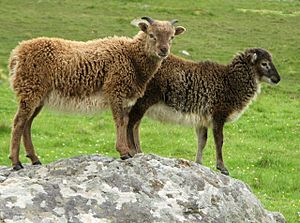
The Western Isles have only two native land mammals: red deer and otters. Other animals like rabbits, blue hares, hedgehogs, brown and black rats, feral cats, mink, and polecats were brought by humans. We're not sure how mice and voles arrived.
There has been some debate about hedgehogs on South Uist. They are not native; they were brought in the 1970s to control garden pests. Now, they threaten the eggs of ground-nesting wading birds in the nature reserve. In 2003, Scottish Natural Heritage started removing hedgehogs from the area.
American mink are another introduced species (they escaped from fur farms). They cause problems for native ground-nesting birds, the local fishing industry, and chicken farmers. Because of this, and after successfully getting rid of mink from the Uists and Barra, the Hebridean Mink Project is now working to remove mink from Lewis and Harris.
The Shiant Islands have a colony of black rats, which might have come from a shipwreck. Apart from a few small islands, the Shiants are the only place in the UK where the black rat (Rattus rattus) can still be found. There are thought to be about 3,000 rats there. Studies show they eat seabirds, but it's unclear if they hunt live birds or just eat dead ones.
A special kind of wood mouse called the St Kilda field mouse lives only on St Kilda. A type of house mouse called Mus musculus muralis disappeared completely after people left the island, as it lived only in buildings. It was similar to a mouse found on Mykines island in the Faroe Islands.
The St Kildans used to keep up to 2,000 sheep, which were removed when the island was evacuated. However, a group of 107 native Soay sheep were moved from Soay island to Hirta and now live wild. Soay sheep are a very old breed that don't need shearing. Their numbers on Hirta vary from 600 to 1,700, and 200 remain on Soay. Some have been sent to other countries because they are tough and small. On Hirta and Soay, they like pastures with plants that grow well near sea spray, like red fescue, sea plantain, and sea pink. There is also a wild breed of sheep on Boreray, which is one of the most endangered British sheep.
Some people claim that bats live in the Stornoway castle grounds. Also, there are farmed animals like sheep, cattle, and a few pigs.
Reptiles and Amphibians: Cold-Blooded Creatures
Like Ireland, Lewis has no snakes. The only reptile is the slow-worm, which looks like a snake but is actually a legless lizard. The common frog can be found in the island's center, but it, along with any newts or toads, were brought here by humans.
Insects: Tiny Island Dwellers
The island's most famous insect is the Highland midge, which is always around water at certain times of the year.
During summer, you can find several kinds of butterflies and dragonflies, especially outside Stornoway.
The rich insect life on Lewis is clear from the fact that carnivorous plants, like the sundew, grow well in some parts of the island.
Plant Life: Greenery of the Outer Hebrides
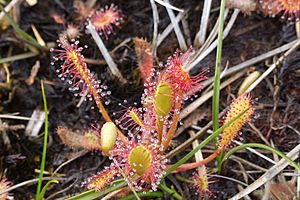
The machair is famous for its different types of orchids and other plants like various grasses. Three kinds of heather (ling, bell heather, and cross-leaved heather) cover large areas of moorland. These areas also have many insect-eating plants like sundews. The vast heather moors explain the island's Gaelic name, Eilean an Fhraoich, which means "The Heather Isle."
Lewis was once covered in forests, but the only natural woods left are small patches on cliffs and islands within lochs, safe from fires and sheep. In recent years, the Forestry Commission planted spruce and pine trees. However, most of the pines were destroyed by moths. The most important mixed woods are those planted around Lews Castle in Stornoway, which date back to the mid-1800s.
Bonnie Prince Charlie's flower (Calystegia soldanella), said to have grown from French seeds dropped by Bonnie Prince Charlie, is found only on Vatersay and Eriskay in Scotland.
St Kilda: Unique Island Plants
Plant life on St Kilda is greatly affected by salt spray, strong winds, and acidic, peaty soils. No trees grow on the islands. However, there are over 130 different flowering plants, 162 kinds of fungi, and 160 bryophytes (mosses and liverworts). Several rare types exist among the 194 lichen species. Kelp grows well in the surrounding seas, which also have many unusual sea creatures without backbones. The St Kilda dandelion is a type of dandelion found only on the island of Hirta, discovered in 2012.
Mingulay: A Single Tree and Rare Flowers
On Mingulay, there is only one tree: a 2-meter-high poplar on a cliff overlooking Mingulay Bay. Sea holly, which is rare in the Western Isles, has grown on Mingulay since at least the late 1800s. Sea milkwort, usually found at sea level, can grow on the high cliff tops here because of the ocean spray and seagull droppings.
Protected Areas: Keeping Wildlife Safe
Isle of Lewis: Important Habitats
Lewis has 15 Sites of Special Scientific Interest (SSSIs) for biology, spread across the island. The Lewis Peatlands are also recognized as a Special Protection Area, Special Area of Conservation, and a Ramsar site. This shows how important they are as a wetland home for migratory and resident birds.
Balranald RSPB Reserve: A Haven for Corncrakes
The RSPB reserve at Balranald is on the far western tip of North Uist. It includes sandy beaches, rocky shores, marshes, and sand dunes. An information center explains how traditional farming helps corncrakes and other wildlife.
Many wading and farmland birds nest on the flower-filled machair and farmlands. This is probably your best chance to hear and even see corncrakes.
South Uist Nature Reserve: Diverse Ecosystems
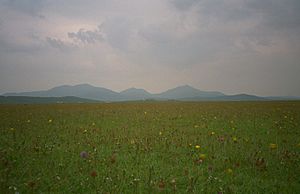
Loch Druidibeg in the north of South Uist is a national nature reserve managed by Scottish Natural Heritage. The reserve covers 1,677 hectares (about 4,144 acres) of machair, bogs, freshwater lochs, estuarys, heather moorland, and hills. Over 200 kinds of flowering plants have been found here, some of which are rare in the country. South Uist is considered the best place in the UK for a water plant called slender naiad, which is a protected species in Europe.
Important numbers of breeding wading birds also live here, including redshank, dunlin, lapwing, and ringed plover. The reserve is also home to greylag geese on the loch and, in summer, corncrakes on the machair. Otters and hen harriers are also seen.
Monach Islands Nature Reserve: Seals and Seabirds
The Monach Islands are a national nature reserve known for their untouched machair and their grey seal population. About 10,000 grey seals come ashore each autumn to have their pups and mate. This makes it one of the largest such colonies in the world. There are also many nesting seabirds and a rich variety of plants. Grey herons nest in some of the old, abandoned buildings.
Mingulay and Berneray: Important Breeding Grounds
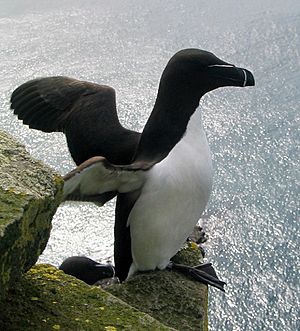
Mingulay and nearby Berneray became a Site of Special Scientific Interest in 1983. Mingulay has a large seabird population and is an important breeding ground for razorbills (9,514 pairs, 6.3% of the European population), guillemots (11,063 pairs), and black-legged kittiwakes (2,939 pairs). Shags (694 individuals), fulmar (11,626 pairs), puffins (2,072 pairs), storm petrels, common terns, Arctic terns, bonxies, and various types of gulls also nest on the sea-cliffs.
Sheep graze on the island's rough pastures, and there is a population of rabbits, brought by shepherds after the island was evacuated in 1912. Grey seals are plentiful, and their numbers have grown a lot since people left. Although they don't breed here, up to 1,000 use the beach in winter.
Flannan Isles: Remote Bird Sanctuaries
The Flannan Isles provide nesting spots for many seabirds, including Atlantic puffins, northern fulmars, European storm-petrels, Leach's petrels, common shags, and black-legged kittiwakes. There is a gannetry (a colony of gannets) on Roaireim. From the late Middle Ages, people from Lewis often visited these nests to collect eggs, birds, and feathers.
There is a population of Arctic hares, brought to the islands by lighthouse keepers. Farmers from Bernera graze sheep on the most fertile islands.
Minke and pilot whales, as well as Risso's and other kinds of dolphins, are often seen nearby.
The islands became a Site of Special Scientific Interest in December 1983.
St Kilda: A World Heritage Site
Quick facts for kids St Kilda * |
|
|---|---|
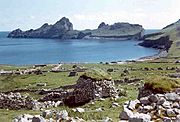 |
|
| Country | |
| Type | Mixed |
| Criteria | iii, v, vii, ix, x |
| Reference | 387 |
| Region ** | Europe and North America |
| Inscription history | |
| Inscription | 1986 (10th Session) |
| Extensions | 2004; 2005 |
|
|
When the Marquess of Bute passed away in 1956, his will left the islands to the National Trust for Scotland. They accepted the offer in 1957. The slow process of fixing up and preserving the village began, often with help from summer volunteers. Also, scientific research started on the wild Soay sheep and other parts of the natural environment. In 1957, the area was named a national nature reserve.
In 1986, St Kilda became the first place in Scotland to be listed as a UNESCO World Heritage Site for its natural features on land. In 2004, St Kilda also got a "marine" status for its amazing underwater features, homes for rare animals, and its globally important seabird population. By 2005, St Kilda became one of only about two dozen places in the world to be a World Heritage Site for both its 'natural' and 'cultural' importance. It shares this honor with famous places like Machu Picchu in Peru and Mount Athos in Greece.
The St Kilda World Heritage Site covers a total area of 24,201.4 hectares (about 93.4 square miles), including both land and sea. The land area is 854.6 hectares (about 2,111.8 acres).
St Kilda is a Scheduled Ancient Monument, a National Scenic Area, a Site of Special Scientific Interest, and a European Union Special Protection Area. Boats can find shelter in Village Bay, but visitors who want to land should contact the National Trust for Scotland beforehand. There is concern about new animal and plant species being brought into this delicate environment.
St Kilda's underwater caves, arches, and chasms offer an exciting diving experience. The power of the North Atlantic waves is so strong that their effects can be felt 70 meters (about 230 feet) below sea level. In 2008, the National Trust for Scotland got support to make sure no rats came ashore from The Spinningdale, a Spanish fishing boat that got stuck on Hirta. There was worry that birds on the island could be seriously harmed. Luckily, possible pollutants from the boat, like fuel, oils, and food, were successfully removed before the bird breeding season in early April.



